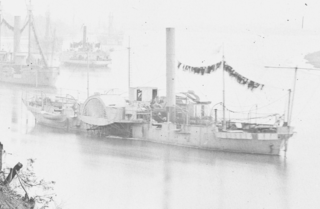
USS Brooklyn was a sloop-of-war authorized by the U.S. Congress and commissioned in 1859. Brooklyn was active in Caribbean operations until the start of the American Civil War at which time she became an active participant in the Union blockade of the Confederate States of America.
USS A. Houghton – a 326 ton bark – was purchased during the beginning of the American Civil War by the Union Navy.

The first USS Miami was a side-wheel steamer, double-ender gunboat in the United States Navy during the American Civil War.

The first USS Pensacola was a screw steamer that served in the United States Navy during the U.S. Civil War.

USS Richmond was a wooden steam sloop in the United States Navy during the American Civil War.

USS Stars and Stripes was a 407-ton steamer acquired by the U.S. Navy and put to use by the Union during the American Civil War.

The first USS Ossipee was a wooden, screw sloop-of-war in commission in the United States Navy at various times between 1861 and 1889. She served in the Union Navy during the American Civil War. She was named for the Ossipee River of New Hampshire and Maine. The USS Ossipee was present during the Alaska Purchase.

The first USS Seminole was a steam sloop-of-war in the United States Navy during the American Civil War.

The first USS Pocahontas, a screw steamer built at Medford, Massachusetts in 1852 as City of Boston, and purchased by the Navy at Boston, Massachusetts on 20 March 1855, was the first United States Navy ship to be named for Pocahontas, the Algonquian wife of Virginia colonist John Rolfe. She was originally commissioned as USS Despatch – the second U.S. Navy ship of that name – on 17 January 1856, with Lieutenant T. M. Crossan in command, and was recommissioned and renamed in 1860, seeing action in the American Civil War. As Pocahontas, one of her junior officers was Alfred Thayer Mahan, who would later achieve international fame as a military writer and theorist of naval power.
USS Narcissus – a screw steamer launched in July 1863 as Mary Cook at East Albany, N.Y. – was purchased by the Union Navy at New York City on 23 September 1863 from James D. Stevenson; and commissioned at New York Navy Yard on 2 February 1864, Acting Ensign William G. Jones in command.

USS Young America was a Confederate steamer captured by the Union Navy’s blockade vessels, and subsequently placed in-service in the Union Navy during the American Civil War.
USS Zouave was a steamer acquired by the Union Navy during the American Civil War. She was needed by the Navy to be part of the fleet of ships to prevent blockade runners from entering ports in the Confederacy.

USS Aroostook was a Unadilla-class gunboat built for the Union Navy during the American Civil War. Aroostook was used by the Navy to patrol navigable waterways of the Confederacy to prevent the South from trading with other countries.
USS Cowslip was a steamer acquired by the Union Navy during the American Civil War.
USS Althea was a screw steamer acquired by the Union Navy during the American Civil War. The Union Navy used her as a tugboat, a torpedo boat, and as a ship's tender in support of the Union Navy blockade of Confederate waterways.

USS Antona was a steamer captured by the Union Navy during the American Civil War. She was used by the Union Navy as a dispatch boat and gunboat in support of the Union Navy blockade of the Confederate States of America.
USS Arletta was a schooner acquired by the Union Navy during the American Civil War. She was used by the Union Navy as a gunboat and, at times, an ammunition ship, in support of the Union Navy blockade of Confederate waterways.
USS Pink was a steamer commissioned by the Union Navy during the American Civil War. She served the Union Navy's struggle against the Confederate States of America in various ways: as a tugboat, a gunboat, and as a small transport.
USS Tritonia was a 202-ton steamer commissioned by the Union Navy during the American Civil War.

The third USS Virginia was a 581-ton blockade-running steamer captured by the United States Navy and put to use by the Union Navy during the American Civil War. Virginia served the U.S. Navy primarily as a mortar gunboat. Her ordnance included six 24-pounder howitzers and a 12-pounder rifled gun.











